14th century
| Millennium |
|---|
| 2nd millennium |
| Centuries |
| Timelines |
|
| State leaders |
| Decades |
| Categories: |
|
Births – Deaths Establishments – Disestablishments |
The 14th century lasted from 1 January 1301 (represented by the Roman numerals MCCCI) to 31 December 1400 (MCD). It is estimated that the century witnessed the death of more than 45 million lives from political and natural disasters in both Europe and the Mongol Empire.[1][2] West Africa experienced economic growth and prosperity.
In Europe, the Black Death claimed 25 million lives – wiping out one third of the European population[3] – while the Kingdom of England and the Kingdom of France fought in the protracted Hundred Years' War after the death of King Charles IV of France led to a claim to the French throne by King Edward III of England. This period is considered the height of chivalry and marks the beginning of strong separate identities for both England and France as well as the foundation of the Italian Renaissance and the Ottoman Empire.
In
In
In the Americas, the Mexica founded the city of Tenochtitlan, while the Mississippian mound city of Cahokia was abandoned.
1301–1309
- The Little Ice Age was a period of wide-spread cooling which, while conventionally defined as extending from around the 16th to the 19th centuries, is dated by some experts to a timespan from about 1300 to about 1850, during which average global temperatures dropped by as much as 2°C (3.6°F), particularly in Europe and North America. This created conditions for a shortened growing season and reduced crop yields that led to the famines in those areas.
- 1305–1314: The Trials of the Knights Templar. The Knights Templar arrested and tried. Jacques de Molay, the last grand master of the Templars, is executed in 1314.
- 1309: King Jayanegara succeeds Kertarajasa Jayawardhana as ruler of Majapahit.[7]
- 1309–.
1310s
- The Great Famine of 1315–1317 kills millions of people in Europe.
- 1318–1330: An Italian Franciscan friar, Mattiussi, visited Sumatra, Java, and Banjarmasin in Borneo. In his record he described the kingdom of Majapahit.
1320s
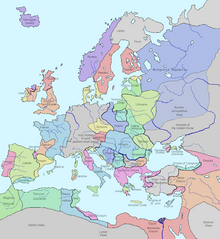
- King of Polandwhich leads to its later unification.
- 1323: Malietoafaiga ordered cannibalism to be abolished in Tutuila (present-day American Samoa).
- Mexica found the city of Tenochtitlan.
- 1327: Tver Uprising against the Golden Horde.
- 1328: Tribhuwana Wijayatunggadewi succeeds Jayanegara as ruler of Majapahit.
- 1328–
1330s
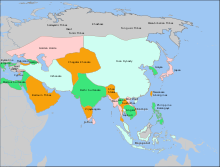
- Abu Saidcauses the disintegration of the Mongol rule in Persia.
- 1336: The Vijayanagara Empire is founded in South India by Harihara I.
- 1337: The Hundred Years' War begins when Edward III of England lays claim to the French throne.
1340s
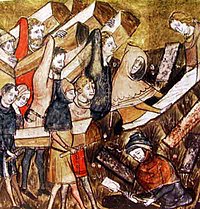
- 1343–1345: In Saint George's Night Uprising, pagan Estonians launch a last large-scale attempt to rid themselves of the non-indigenous Christian religion.
- 1345–1346: The French recruit troops and ships in Genoa, Monaco, and Nice.
- 1346: English forces led by Edward III defeat a French army led by Philip VI of France in The Battle of Crécy, a major point in the Hundred Years' War which marks the rise of the longbow as a dominant weapon in Western Europe.
- 1346: King Valdemar IV of Denmark sells the Duchy of Estonia to the Teutonic Order.
- 1347–1351: The Black Death kills around a third of the population of Europe.[9]
- 1347: Pagarruyung, West Sumatra.[10]
- Black Death and Great Famine, fueling fears that the Biblical Apocalypse had arrived.
1350s
- 1350: Ramathibodi I establishes the Ayutthaya Kingdom.
- 1350: Hayam Wuruk, styled Sri Rajasanagara, succeeds Tribhuwana Wijayatunggadewi as ruler of Majapahit; his reign is considered the empire's 'Golden Age'.[7] Under its military commander Gajah Mada, Majapahit stretches over much of modern-day Indonesia.
- 1353: Fa Ngum established the Lan Xang kingdom in Laos.
- 1356: The Imperial Diet of the Holy Roman Empire headed by Emperor Charles IV issues the Golden Bull of 1356, establishing various constitutional aspects of the Empire, the most significant being the electoral college to elect future emperors.
- 1356: The Diet of the Hansa is held in Lübeck, formalising what up until then had only been a loose alliance of trading cities in northern Europe and officially founding the Hanseatic League.
- 1357: Scotland retains its independence with the signing of the Treaty of Berwick, thus ending the Wars of Scottish Independence.
- 1357: In the Battle of Bubat, the Sundanese royal family is massacred by the Majapahit army by the order of Gajah Mada; the death toll includes Sundanese king Lingga Buana and princess Dyah Pitaloka Citraresmi, who committed suicide.[11]
1360s
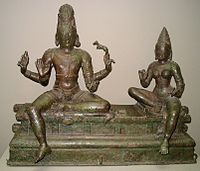
- Zhu Yuanzhang, takes place from August to October, constituting one of the largest naval battles in history.
- Nagarakertagama is written.[7]
- MexicaEmpire.
- .
1370s
- 1371: The Battle of Maritsa, the Serbs are defeated by the Ottomans, with most of Serb nobility being killed.
- 1378: The Great Schism of the West splits the Catholic Church, eventually leading to three simultaneous popes and not resolved until 1417.
- 1378: Battle of the Vozha River between Russians and Mongols.
- 1378–1382: Ciompi Revolt occurs in Florence.
1380s
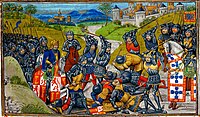
- 1380: Russian principalities defeat the Golden Horde at the Battle of Kulikovo.
- .
- 1381: Peasants' Revolt in England.
- 1382: Khan Tokhtamysh captures Moscow.
- 1382: Burji dynasty, the Circassian Mamuluk Dynasty in Egypt.
- 1385: Battle of Aljubarrota between Portugal and Castile. Portugal maintains independence.
- 1385: Union of Krewo between Poland and Lithuania.
- Prince Lazar, Sultan Murad I and Miloš Obilićare killed.
- 1389: Wikramawardhana succeeds Sri Rajasanagara as ruler of Majapahit.[7]
1390–1400
- pogroms spread throughout Spain and Portugal, and many thousands of Jewsare massacred.
- Joseon Dynasty.
- 1396: The Battle of Nicopolis, in which the Ottoman Empire defeats a large Crusader army of knights and infantry from various Christian kingdoms including Hungary, France, the Holy Roman Empire, Burgundy and Wallachia.
- Ivan Sratsimirby the Ottomans.
- 1397: The Kalmar Union is established, uniting Norway, Sweden and Denmark into one kingdom.
- 1397: Reign of Chimalpopoca begins as the third tlatoani of Tenochtitlan.
Undated
- Transition from the Medieval Warm Period to the Little Ice Age.
- Crisis of the Late Middle Ages
- The poet Petrarch coins the term Dark Ages to describe the preceding 900 years in Europe, beginning with the fall of the Western Roman Empire in 476 through to the renewal embodied in the Renaissance.
- Beginning of the Ottoman Empire, early expansion into the Balkans.
- , is built.
- Early 14th century: Kao Ninga paints Monk Sewing (attributed) in the Kamakura period (Cleveland Museum collection).
- An account of saints.[12]
- Singapore emerges for the first time as an important fortified city and trading centre.
- Islam reaches Terengganu, on the Malay Peninsula as evidence by the Terengganu Inscription Stone.
- The Hausa found several city-states in the south of modern Niger.
- Work begins on the Great Enclosure at Great Zimbabwe, built of non-cemented, dressed stone. Research suggests the city's population to be between less than 10,000 to 18,000 at its peak.[13][14]
Inventions, discoveries, introductions
- Music of Ars nova
- Foundation of the University of Kraków
- Chinese text the Huolongjing by Jiao Yu describes fire lances, fire arrows, rocket launchers, land mines, naval mines, bombards, cannons, and hollow cast iron cannonballs filled with gunpowder, and their use to set ablaze enemy camps
- First pound lock in Europe reportedly built in Vreeswijk, Netherlands in 1373[15]
References
- ^ "History of Europe - Crisis, Recovery, Resilience | Britannica". www.britannica.com. Retrieved 2023-12-28.
- ^ "The Black Death in Asia, Europe, and Africa" (PDF). Oxford University Press. Retrieved December 28, 2023.
- ^ Black Death, Encyclopaedia Britannica
- ISBN 978-81-8069-149-2.
Bengal [...] was rich in the production and export of grain, salt, fruit, liquors and wines, precious metals and ornaments besides the output of its handlooms in silk and cotton. Europe referred to Bengal as the richest country to trade with.
- ^ a b Thad Morgan, "This 14th-Century African Emperor Remains the Richest Person in History" Archived 2019-05-01 at the Wayback Machine, History.com, March 19, 2018
- ^ Money.com. Archivedfrom the original on June 9, 2022. Retrieved January 5, 2017.
- ^ a b c d e Ricklefs (1991), page 18
- ^ "Asian maritime & trade chronology to 1700 CE". Maritime Asia.
- ^ Howard, Jenny (2020-07-06). "Plague was one of history's deadliest diseases—then we found a cure". National Geographic. Archived from the original on March 5, 2021. Retrieved 2022-08-27.
- ^ Kern, J.H.C., (1907), De wij-inscriptie op het Amoghapāça-beeld van Padang Candi(Batang Hari-districten); 1269 Çaka, Tijdschrift voor Indische Taal-, Land-, en Volkenkunde.
- ^ Drs. R. Soekmono; et al. (1988) [1973]. Pengantar Sejarah Kebudayaan Indonesia 2, 2nd ed (5th reprint ed.). Yogyakarta: Penerbit Kanisius. p. 72.
- ^ Macdonnel, Arthur Anthony (1900). " Sanskrit Literature and the West.". A History of Sanskrit Literature. New York: D. Appleton and Co. p. 420.
- PMID 28614397.
- ISBN 978-0-299-13124-1.
- ^ "pound lock". August 15, 2011. Archived from the original on 2011-08-15.
